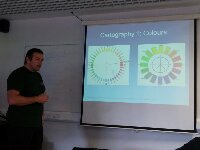 Through GPS and tracking technologies, there now exists an abundance of space-time trajectory data, and this resource is exponentially increasing in size. The lion’s share of this dataset comes from humans and mobile devices such as smartphones, but a significant mass of data relates to animal movement, collected through portable devices attached to the animal. The problem to be addressed ins this: Taking into account a dataset relating to even a single animal, conventional mapping techniques would render all but the simplest dataset as an uninterpretable ‘scribble’. To address this, an adaption of the REMO method (which transforms a set of space-time trajectories into a grid of directions travelled, or velocities, with listed trajectories discretised into regular time intervals) will be outlined. The modified version reorders trajectory lines according to proximity through simulated annealing, an optimizing method. Featured space-time data will be selected from an assembled dataset collected from sealions, feral cats, hedgehogs, dolphins and buff weka.
Through GPS and tracking technologies, there now exists an abundance of space-time trajectory data, and this resource is exponentially increasing in size. The lion’s share of this dataset comes from humans and mobile devices such as smartphones, but a significant mass of data relates to animal movement, collected through portable devices attached to the animal. The problem to be addressed ins this: Taking into account a dataset relating to even a single animal, conventional mapping techniques would render all but the simplest dataset as an uninterpretable ‘scribble’. To address this, an adaption of the REMO method (which transforms a set of space-time trajectories into a grid of directions travelled, or velocities, with listed trajectories discretised into regular time intervals) will be outlined. The modified version reorders trajectory lines according to proximity through simulated annealing, an optimizing method. Featured space-time data will be selected from an assembled dataset collected from sealions, feral cats, hedgehogs, dolphins and buff weka.
Skip to content

Interaction Design Centre
at Middlesex University
Leave a Reply